
Sylvia Gunnery.
Profile by Dave Jenkinson.
Books by Sylvia Gunnery.
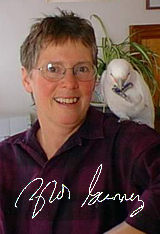 Sylvia Gunnery's writing is for the birds. Well, one bird in particular. "I have two cockatoos and two love birds. When I'm typing away, I say to Cory, one of the cockatoos, 'Want to write a book?' and he flies over and sits on my shoulder. If I'm in bed reading a hardcover book, Cory will sometimes sit on my hand and complain when I turn the pages. I live alone, and, while it's nice to live alone, it can be a lonesome thing, especially as a writer because you live inside your head so much. It's a bit schizophrenic."
Sylvia Gunnery's writing is for the birds. Well, one bird in particular. "I have two cockatoos and two love birds. When I'm typing away, I say to Cory, one of the cockatoos, 'Want to write a book?' and he flies over and sits on my shoulder. If I'm in bed reading a hardcover book, Cory will sometimes sit on my hand and complain when I turn the pages. I live alone, and, while it's nice to live alone, it can be a lonesome thing, especially as a writer because you live inside your head so much. It's a bit schizophrenic."
Born in Halifax, Nova Scotia, on October 17, 1946, Sylvia completed all her public schooling in that city. "While I took a B.A. at Acadia University, I also completed a secretarial science diploma. As I was one of the first two women in my neighbourhood to go to university, my dad said, 'If I'm going to spend all this money to send you to school, you have to learn how to type.' To Dad, women who typed more easily got jobs. Then I went to Dalhousie and did a B.Ed. and later, having gone to the Banff School of Fine Arts in 1976, I returned to Dal for an M.Ed. in Curriculum Development and Writing. The Banff School with W.O. Mitchell was just 'huge.' As a teacher, I became so strong because I suddenly knew how to teach writing. A lot of people teach writing from a false surface, and they don't allow kids to understand what writing's for and where it comes from. Banff taught me that."
To date, Sylvia's four YA novels have all treated the various developmental tasks which adolescents encounter during their middle school years, but, in particular, she has examined diverse aspects of adolescents' need to develop new relationships with people their own age while changing their relationships with their parents. Sylvia's skill as a storyteller she attributes, in part, to geography. "There's a tradition of storytelling that's quite Maritime. When I was growing up, we would sit around the dinner table at home, my parents, sister Barb, and my grandfather and godmother who also lived with us, and 'talk.' I would tell them stories of what happened at school, and I quickly learned to embellish and make people laugh. Barb and I shared a bedroom, and, when we turned off the light, Barb, because she was older and could control me, would make me tell her a story. I would invent them, and Barb probably slept through half of them."
Early schooling also played a role in Sylvia's becoming a writer. "My elementary school teachers knew and understood me. They encouraged me to write. Mrs. Walton, my principal at Halifax's Mulgrave Park Elementary School, read one of my stories on the PA and suggested to me that I become a journalist. For ages I said I was going to be a journalist until I looked it up and thought, 'I don't want to write stuff that happens. That's no fun.' Mrs. Walton didn't think to say I could write stories. When I hit junior high, we didn't write nor did we in high school or university, and so I put it all aside for basketball, boys and fun. However, when I graduated from university, every time I went on holidays, I found myself buying a new blank book and writing about the holiday but stretching it just like I did around the kitchen table. By then I was about 28 or so, and I said, 'I do want to write.' I saw an ad in Quill & Quire and went to Banff."
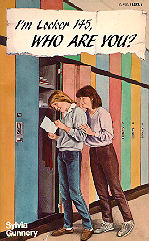
"Following Banff, the first stuff I wrote was adult short fiction, and I was published in Canadian Fiction magazine and Grain. I was trying to get my short stories out there but was not being successful. During the year I took to do my Master's at Dalhousie, I won prizes for a short story and an essay and felt really good. John David Merchant, a very close friend and a former teacher who had become a book rep for Scholastic, suggested, 'You're always telling stories about school. Why don't you write some?' I went, 'Hmmm, I never thought of that,' sat down and 'poof,' I'm Locker 145, Who Are You?. John was going to Toronto for a meeting and offered, 'I'll take your manuscript with me and hand it right to the editor.' When he came back, he said, 'Sylvia, the editor opened her bottom drawer and said, "There's my novel. Everybody's got a novel.'" However, Scholastic later wrote me saying, 'It's 95% there."

"After I'd written Locker 145, I was visiting a school where a girl asked, 'How come there are no sports books for girls?' Having been an athlete in my youth, having played volleyball on the 1961 Richmond Junior High Halifax City Champs and having been the coach at Timberlea Junior High School, I 'knew' volleyball. I said, 'I'm your man. I can do this,' and so Taking Sides started to form in my head as a girls' book about volleyball, but not as a 'jock book.' I started writing it and picturing Zena, a grade 9 girl on my Timberlea volleyball team. Zena was a very fine athlete but not a good student academically. She was kind of overweight too, but on the gym floor, she just had such confidence, such sportsmanship, such ballet."
"All my books start with somebody I know, and I have to write for a while until that face changes and fades and fiction takes over. I wish I could be an artist and sketch how the change happens gradually until 'boom' there's this new person. So Taking Sides' Lea started out as Zena who lost finesse, lost weight, and became a grade 7 student. All these things were happening when I thought, 'Zena is black; Lea, my main character, is black. OK Gunnery, what do you know about "black"?' Suddenly I realized, 'This is not a volleyball book you're writing. You're really writing something else you experienced at Timberlea, and what you experienced in a school of 220 kids, 40 blacks, is the racism that the blacks show the whites and the whites show the blacks."
"I had to explore that culture and make sure I understood what I thought I understood. I was brought up in the north end of Halifax near the black community of Africville which got wiped out. My first teacher was a black teacher, and so it wasn't a coincidence that I was starting, as a writer, to explore that community that I had touched on all my life but had not been a part of. And the biggest thing I had to face was my own racism. Nobody likes to say that they're racist, and I certainly was too polite to be openly racist, but who were my black friends? Nobody. I came to understand that my 'racism' really wasn't what people in this day would call racism. It was an unfamiliarity, a shyness, a feeling that I noticed 'blackness' every time because I didn't understand it. Taking Sides made me understand it, and now I don't see black like I used to."
"Part of my way of understanding the black side of the culture inside my culture was to speak to the black students. One of them said, 'You're writing about me.' 'No,' I replied. 'But you can help me out if you could read some stuff.' One of the scenes I gave her was the kitchen scene where, after Lea has hit Monica, the parents are talking 'past' her. After the student had read the scene, she asked, 'Can I take this home?" I thought, 'Oh my god! What am I getting into here?' but I agreed. She came back the next morning and said, 'My father has a message for you,' and I really did panic because I thought, 'Oh yeh. White woman tells black person's story.' But his message was, 'Has that woman been in our kitchen?' I gave her the biggest hug."
"When Scholastic saw the first draft of Taking Sides, they said, 'We like it, but the teacher is unbelievable,' and I laughed and replied, 'Well, I'm not going to change her too much because I kind of just put myself in there. You have to believe that there are people that sensitive out there. Let's not always have teachers as the cliche insensitive persons.' I did sit on the school's steps with kids who were going to harass another student, and, as a way of letting that kid walk past, I did pretend I didn't know why they had all gathered there. Scholastic also said, 'We don't like how Monica doesn't change at the end and that she gets the prize,' to which I responded, 'You know, that's one of the things about racism. A lot of people don't change, and a lot of them become winners. I'm not changing that part of the novel either."
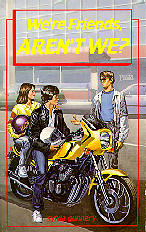
"While my books start with someone I know, there's also a bit of me in every single one. I was in love with a guy who had a motorcycle, and I was the high academic so there's a lot of me in We're Friends, Aren't We?. I think you have to be in every book or else the book isn't going to make it. While I'm the teacher in Taking Sides, it's my former junior high volleyball coach's body, her pearls, her starched blouse. It's her body and my personality. With Chewing Gum and Other Crimes, in my late 20's, early 30's, I used to be the stage manager of a theatre troupe, so I know whereof I speak when I say: 'Cue this.' 'Up that.' 'Lights down.'"
"When it comes to writing, I'm not a plotter. I'd hate that. I tried to write Harlequin Romances once with a friend who had been published and wanted a writing partner. I worked with her for a couple of years, and we failed because my soul wasn't there. We plotted them out, but once it was plotted out, what the heck's the point? The surprise of wondering is missing. I can recall sitting at my dinner table with a friend and saying, 'This friendship between Elizabeth and Woody in We're Friends is driving me nuts. She's so self-centred. I don't know whatever would help her realize that Woody is a friend. Suddenly I saw Woody dead, and I started to cry, 'What have I done?' And my friend suggested, 'You're the writer. Don't write it." 'But,' I replied, 'it's already happened.' I went into my bedroom, and I wrote and cried and finished the scene and said, 'Thank God it's over. I won't have to cry any more.' But, because I didn't have a computer at the time, with every new draft, I cried again."
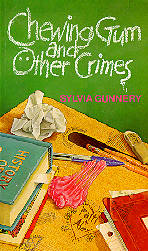
"Another example of my non-plotting occurred in Chewing Gum and Other Crimes. I had no idea I was going to write about marijuana. That book came out of one of my students whose single-parent dad was always saying, 'He's lazy,' and I said, 'Your son is not lazy. Look at this and this.' But it seemed like the dad would never change his opinion and that stayed in my head and Alex grew out of it. The day it occurred to me to put marijuana into the book, I was driving alone to visit my parents who live an hour outside Halifax. It's funny how the brain works when you're not thinking about something. It was a beautiful sunny Sunday morning, and I 'saw' this kid standing in a washroom reading a book. I felt like pulling the car over and 'watching' the movie in my head. Then I just blanked it, thinking, 'Wait until you get home to write this.'"
"And when I got home and started writing, the boy was reading a book, and then I thought, 'He's selling dope, and I'm going to put this in the novel.' When I'm writing a book, I don't wonder about who's going to do what. If I'm going to write about that youth culture, then my imagination will give me the stuff from the culture, and it'll have to go in there. It can't be taken out because somebody outside the culture doesn't like to look at it."
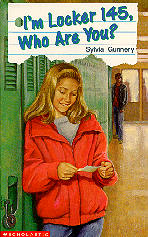
Sylvia hasn't always been pleased by her books' covers and observes, "When I go into schools, kids will talk about covers right away. I really disliked the original cover on Locker 145 because, not only are the colours so bland, but Brenda, the character standing behind Jodi, is supposed to be fat. The new edition's cover is the suggestion I originally had but never gave Scholastic because I was a timid 'new' writer. Since Locker 145, I've said, 'This is what I want on the covers' because I 'know' kids will not only judge a book by its cover but, once they really identify with those cover characters, they keep going."
"With We're Friends, I wanted a motorcycle on the cover and went to one of my students who always had motorcycle magazines. 'Kenny, I'm putting a motorcycle in my book. Would you pick it out?' and Kenny asked, 'Well, what's the guy like?' I replied, 'I don't want to tell you too much about him, but he drives a motorcycle, doesn't do that well in school, but he's OK.' Kenny came the next day with a picture of one of those motorcycles that looks like it got away from itself at the front. 'No way,' I said. 'I want a couple of scenes where Elizabeth's on it. If I'm going to write this book, I've got to get on that bike in my mind, and that'll scare me to death. Aren't there any 'pretty' motorcycles?' Kenny looked at me a little disgustedly, but then he let me flip through the magazine. I picked a yellow bike, and, in retrospect, the colour was probably too wimpy, but I didn't want Cass to be such a cliched bad guy that he'd be on a bad guy's bike."
"One of the things I say to students is that writing a book is like getting ready for school in the morning. You jump out of bed and get all fixed up. You don't put your nose on the mirror to see how you look. You stand back. Writers have their nose on the mirror the whole time no matter how far you think you step back. In fact, the most delightful stages of writing for me are that first stage when I'm so pressed up against the mirror and then that intellectual distance when I'm in that fifth or sixth draft and I'm just starting to hear the rhythms and it's become another kind of puzzle, an intellectual puzzle. But we really are so close to what we are writing that we don't always see."
"For example, when I sent Scholastic We're Friends, the editor said, 'The first of it's slow,' which is very polite talk for 'boring.' And I thought, 'Slow? I love those characters.' And that was the problem. My original opening scene had Woody quitting smoking. As early as my second draft, I knew Woody was going to die, and so as I was fine tuning the book, it was quite tender to me that Woody had made this decision, but it took the editor's remark to trigger me to realize that I wasn't removed enough. What had been pulling me through all those other drafts were those tender feelings and my not wanting readers to know Woody was dead."
"Since 1993, I've been teaching grades 10-12. Before that, I taught junior high: English and PDR, "'Personal Development and Relationships' (aka 'Sex, Drugs and Rock'n Roll'), social studies and health. It's wonderful to have had those years of junior high experience because most of the kids I taught at that level were then in front of me as my high school students. Because I'd known them before, I could recognize what was different and not just leap into the strange 'culture' of the high school. I use that word, 'culture,' a lot. A few years ago, the Writers' Union of Canada was talking about voice appropriation. I'm always so frustrated by such talk because I feel that, if I'm an artist, if I'm going to write, am I not then going to explore other cultures?"
"I never really thought of the teen culture as separate because I was in it so much, but I've turned 50, and I'm getting 'wise.' I'm also getting to the point where kids tease me, call me 'Granny' and things like that. I don't look like a granny, but it's their way of saying, 'You're not on our team,' and I worry that my books may not represent their culture. I have to look real hard to make sure I'm really representing it."
"I always think of my writing as a mirror. What I want to do is say to teenagers, 'Here you are. This is who you are, and you count. You don't have to be from New York. This is you in Halifax, in Nova Scotia, and somebody in New York, if they wanted to read it, might relate a bit.' If I'm going to mirror them, then it's those little fine points on the surface of the culture that I have to stay tuned to so they recognize who they are. It's whether the character's skirt is a certain length, or her shoes have great big huge heels or her lipstick is bright red, those are the things where readers will say, 'Aha, I recognize her, and, because I can recognize her, I'll believe her tears.'"
"The book I'm working on right now started with a really troubled young man (let's call him 'Jack') with a shaved head and plaid jacket who was in my high school class. He'd flunked a grade so he's almost 18. I had 30 pages written before I realized it was 'Jack' I was tuned into. I didn't know that at first. As a high school teacher, I'm looking at the kids and their sense of 'where the heck do I belong?' That's such a huge issue with kids today. When I first met 'Jack,' you could see how fragile he was. I guess he'd just come out of a lot of bad drug abuse and an awful time. He said, 'If you'd known me last year, you wouldn't have liked me.' So he's the one who's sent me on this next quest." A late Friday afternoon incident between Sylvia and 'Jack' involved his asking, "Do you ever look at the sky and see all these stars and think, 'What's the point of me being here?'" Sylvia's response became what she describes "as the kind of thing that grabs inside. You know the story has started, but you don't know how many years it's going to take you to be true to it."
As to other future projects, Sylvia says, "Scholastic has rejected a couple of my manuscripts recently. One was a picture book for little kids, and I just think I'm not picture book experienced enough yet. I've done a rewrite that they haven't sent back, but I think they will, and that's OK. I don't think I've got enough of what it takes to be there, but I worked very hard on it, and I still believe in it. Maybe I'll gain the skills through these experiences to do well.
A manuscript that was originally rejected by Scholastic has
now found a home. "'Menace and Mischief' is for a younger
audience than my other novels --ages 8 - 12, I'd say. Actually,
I started this book about seven years ago when I found a novel
I'd been trying to write was just too depressing for me to 'stay
inside' for any length of time. My dad had died a year before,
and it was time, personally, for me to cheer up. So I really
played with this book -- became downright silly at times and
laughed out loud about some descriptions and word plays. Last
month, when I was checking the gallies, I was still laughing.
Now, lots of people have not found it nearly as funny as I have,
but therein lies my state of mind. Ha. For example, there's a
scene where CJ has been called to watch TV with his parents and
they know something which he doesn't know, and that something is
about to be announced on the cable TV channel. CJ 'noticed that
his mother had a very weird grin on her face, like she'd tied a
camel to the back veranda and was just waiting until someone
walked out there to discover it.' Now that cracks me up. But
I'll understand if you're sitting there scratching your head in
wonderment.
The title of the novel, 'Menace and Mischief' comes out of
the basic reason I wanted to write this book: too often younger
people will not see distinctions between 'just joking around' and
harassment. In 1990, an eighth-grader in my friend's school died
when he was body-checked at a noonhour gym activity. I've
actually included a similar event in this novel. But I didn't
want the novel to be depressing, as I have said. So I mixed up
the zany stuff (like lost hamsters and boa constrictors) with the
serious stuff (like intimidation, and physical violence), hoping
kids would stay with my story and come out the other side
realizing some truth about limitations to what they'd call
'joking around'. That's why Scholastic didn't like the book, as
a matter of fact. They said they thought I had two novels here,
not one. Budge Wilson, in a phone conversation, asked me if I
thought they were right and that started a five-minute tirade
about how the mixture of the two themes was exactly the point of
the whole book!! Budge ordered me to send the manuscript
immediately to Stoddart before I lost confidence. I did, and in
spring '99 my book will be 'out there'. Yaaaaaa."
"Scholastic has asked if I would work on a series and even suggested, 'With Chewing Gum, why don't you go on to Benjamin?' But, like with my other books, the job is done. I'm not curious about Benjamin. I can picture places he goes and things he might do, but I'm not sufficiently curious about him and the issues that'll come up in his life. So I'm not going to do the series. It won't be good writing because I won't be there enough."
"I'm growing as a writer for sure. I think I wrote temporary books, not temporary characters, but temporary books. When I went to Banff in 1976, I didn't know what voice was, let alone believe that somebody would listen to my voice. Rather than write my own environment, which was the junior high school, I was trying to write something else that I perceived someone might want to read. What I learned at Banff was voice, and I started to write from my environment, and it's successful because it's honest. My 'soul' is in there, and I believe in it."
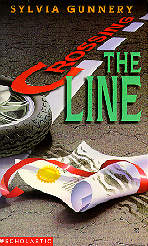
1998 did see the arrival of Crossing the Line which appeared to be a new Gunnery book but really was not. "It had been over ten years since We're Friends, Aren't We? had been published when Scholastic called to tell me they wanted to give it a new face and a new name for 1998. My job, in the summer of 1997, was to go through the novel and 'update' anything which gave it that decade-ago feeling. When I had finished my job, there were 111 changes, exactly! Most were quite minor because we weren't changing the characters or their situations."
"One change which was made many many times had to do with graduation -- in 1985, my students referred to the graduation dance as 'the prom'; but in 1997, it was 'grad' or 'grad dance.' Only once was I able to leave that old-fashioned term in the updated version of the novel and that was when Woody's mom was asking him if he had a date for the prom. She'd say 'prom,' and I can see Woody rolling his eyes but not correcting her. Another minor change was that, in 1997, I had to stuff all the characters' books into 'backpacks' whereas in 1985, most students simply carried them loose in their arms."
"I did begin to notice that my writing style of 1985 was not exactly my current style. A few times, I felt that I was too wordy, describing, for example, how people talked. Now, the words they speak and perhaps their body language convey more clearly what I hear as they speak. And I'm more brief in conversations these days, too. So I cut a bit of chat that had been going no where."
"There was one change which really struck me as a sign of just how much technology can creep into (and out of) our vocabulary. As Elizabeth was leaving her surprise birthday party with her parents, everyone was saying their goodbyes. One person said, "See ya round like a turntable." That had to go! And it sure couldn't be replaced by "See you around like a cd!" Ha. When in doubt, cut it out!"
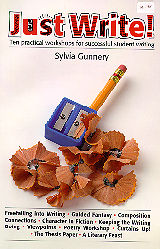
"I have a long way to go in my writing because I'm a really strong teacher. I spend a lot of time in provincial development workshops, and I do a lot of professional writing." One dimension of that professional writing has been the publication of Just Write!, which is subtitled, Ten Practical Workshops for Successful Student Writing. "This professional book for teachers was a very long time in the making. It started, in fact, with some students in my grade 9 class in 1988. I wanted to publish a book about classroom writing in the voices of the student writers, so I convinced about a dozen students who had been in my grade 8 class and now were in my grade 9 class to each take on a chapter as their term writing assignment. For a while, Scholastic did show some interest in the project, but ultimately they felt that teachers were not keen about hearing about classroom practice from students."
"In 1995, I was invited to be part of a team of teachers who would work on the new language arts guides for Nova Scotia. My job in particular was to look at writing goals. After so much concentration on WHAT students should be learning, I felt very strongly that there needed to be some suggestions to teachers about the HOWs of all of that. It was not an easy book to write, at first, because I didn't want to sound like someone shouting, 'Me, me, me!' This is where some of my close teaching friends helped out: they told me to write as if I were explaining to them what goes on in my classroom. I took their advice and found the third draft of the book much more fun to write. Finally, Mary Macchiusi of Pembroke Publishers called and said, 'Welcome to the Pembroke family!'"
"Now I make time for fiction writing on weekends and on holidays. However, if I don't have a story started to the point where that story now has to be told, that's the hardest writing time. So I try to push real hard in the summer to click past that, and then I just find the time because the story's there in my head and I have to do it. But I'm getting 'old,' and I come home from school beat and I might have 75 papers to mark. Consequently, I haven't given the time to my writing that my heart would like. I hope I can be a little old lady writer and do well."
*This article is an updated version of a 1997 "Profile" which was published in Resource Links, 2(2), 56-59.
